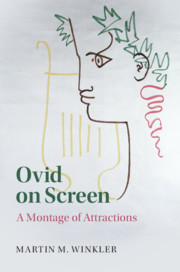Book contents
- Ovid on Screen
- Ovid on Screen
- Copyright page
- Dedication
- Contents
- Illustrations
- Acknowledgments
- D M
- Adages
- Fade-In: Prooemium
- Part I Theory and Practice
- Part II Key Moments in Ovidian Film History
- Part III Into New Bodies
- Chapter 5 Effects and Essences
- Chapter 6 The Beast in Man: Not Ovid’s, but How Ovidian!
- Part IV Love, Seduction, Death
- Part V Eternal Returns
- Sphragis: End Credits
- Bibliography
- Passages of Ovid’s Works
- General Index
- Plate Section (PDF Only)
Chapter 5 - Effects and Essences
from Part III - Into New Bodies
Published online by Cambridge University Press: 27 January 2020
- Ovid on Screen
- Ovid on Screen
- Copyright page
- Dedication
- Contents
- Illustrations
- Acknowledgments
- D M
- Adages
- Fade-In: Prooemium
- Part I Theory and Practice
- Part II Key Moments in Ovidian Film History
- Part III Into New Bodies
- Chapter 5 Effects and Essences
- Chapter 6 The Beast in Man: Not Ovid’s, but How Ovidian!
- Part IV Love, Seduction, Death
- Part V Eternal Returns
- Sphragis: End Credits
- Bibliography
- Passages of Ovid’s Works
- General Index
- Plate Section (PDF Only)
Summary
Chapters 5–6 deal with some of the chief aspects of Ovidian and cinematic metamorphoses. Chapter 5 examines another crucial moment in screen history, when film pioneer Georges Méliès accidentally discovered how bodies and objects could be changed into something completely different on the screen. Ovid’s versions of the myths of the sculptor Pygmalion, whose ivory statue, later named Galatea, comes to life, and, conversely, the petrifying gaze of the Gorgon Medusa initiated two important developments in modern visual arts: the Pygmalion Effect and the Medusa Effect. Related to these are the Hephaestus and Daedalus Effects, in which statues acquire movement. This chapter connects elements from Ovid’s myths to a variety of related film forms and genres. Visible essences and underlying characteristics of bodily metamorphoses are as important for Ovid’s epic as they are for the cinema. The latter has extensively shown complex metamorphoses through editing and camera tricks since the days of silent films and in animated films. Now computer-generated images (CGI) add a whole new dimension of verisimilitude to what is physically impossible. A complex metamorphosis, from human to robot, occurs in Fritz Lang’s silent classic Metropolis, while the metamorphosis of a young ballerina in Black Swan may well be the most realistic change of the human body in the CGI era. The chapter closes with a brief homage to Eisenstein’s famous montage in Battleship Potemkin, in which three marble statues of lions become one animated lion.
Keywords
- Type
- Chapter
- Information
- Ovid on ScreenA Montage of Attractions, pp. 161 - 220Publisher: Cambridge University PressPrint publication year: 2020

